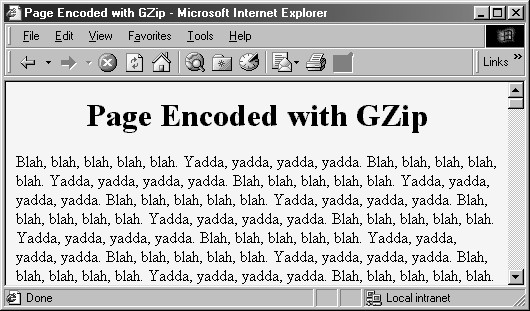


Prentice Hall and Sun Microsystems. Personal use only; do not redistribute.
4.5 Restricting Access to Web Pages
107
Figure 4 3
Since the Windows version of Internet Explorer 5.0 supports gzip, this
page was sent gzipped over the network and reconstituted by the browser, resulting in a
large saving in download time.
4.5 Restricting Access to Web
Pages
Many Web servers support standard mechanisms for limiting access to desig
nated Web pages. These mechanisms can apply to static pages as well as
those generated by servlets, so many authors use their server specific mecha
nisms for restricting access to servlets. Furthermore, most users at e com
merce sites prefer to use regular HTML forms to provide authorization
information since these forms are more familiar, can provide more explana
tory information, and can ask for additional information beyond just a user
name and password. Once a servlet that uses form based access grants initial
access to a user, it would use session tracking to give the user access to other
pages that require the same level of authorization. See Chapter 9 (Session
Tracking) for more information.
Nevertheless, form based access control requires more effort on the part
of the servlet developer, and HTTP based authorization is sufficient for many
simple applications. Here's a summary of the steps involved for basic autho
rization. There is also a slightly better variation called digest authorization,
but among the major browsers, only Internet Explorer supports it.
Second edition of this book: www.coreservlets.com; Sequel: www.moreservlets.com.
Servlet and JSP training courses by book's author: courses.coreservlets.com.
footer
Our partners:
PHP: Hypertext Preprocessor Best Web Hosting
Java Web Hosting
Jsp Web Hosting
Cheapest Web Hosting
Visionwebhosting.net Business web hosting division of Web
Design Plus. All rights reserved



